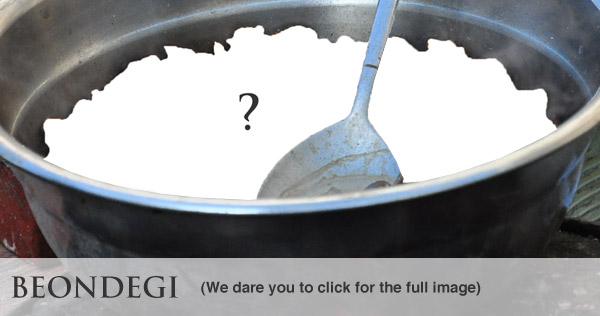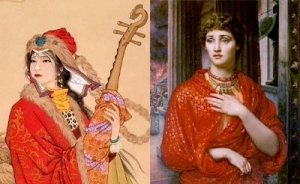Asian Food Review: Part 1
“You dancers are so skinny! You must watch your diets very strictly!” Yes, but not really in my case.
Owing to my inefficient digestive system, gaining weight is almost impossible—to the jealousy of some and my own dismay. It’s even harder to put on mass when sweating often seems like the day’s main activity. So, yes: gaining weight can be a big dilemma for dancers, in the sense that it’s as hard for some to gain weight as it is for others to lose it.
But out of shear benevolence, I decided to put my gastronomic disadvantage to good use by starting a food blog. This is for those of you starving for information about what dancers eat on tour.
Now, it’s a fact that, wherever we go on tour, local organizers take care of us extremely well, especially when it comes to food. Backstage, we are catered to with homemade and sponsored dishes—Thai curry, Brazilian steak, sushi platters, In-N-Out burgers.
On the road, we stop by Chinese restaurants, Mongolian grills, Hibachi grills, and every sort of buffet. When outside the U.S., we spend the rare off day roaming the streets in search of unique cultural cuisine. In short, we’re royally culinarily spoiled.
And now, I will bring some of this past season’s delectable highlights straight to your monitors, how about that?

Where we had it:
San Francisco
What’s in it:
The most common ingredients are wafer-thin beef, pork, lamb slices and a variety of vegetables. But you can throw in just about anything edible, from pumpkin to octopus (not live) to udon noodles. My favorite comestible to throw in the boiling water has to be the enoki (straw mushrooms), due to their unique texture—smooth and slimy, yet crunchy at the same time.
Background:
Chinese hot pot boasts a history of more than 1,000 years, dating back to the Tang Dynasty (618-906). By the Qing Dynasty (1644-1911), hot pot became popular throughout China, even inside the Forbidden City’s imperial court.
Different regions have different hot pots. As seemingly all Szechuanese food, the Chongqing hot pot has a super spicy “mala” soup base which numbs the tongue. The northeastern Manchurian hot pot uses a lot of sauerkraut (suancai).
In cold regions, the hot pot warms the soul in winter. In the sultry southern summer, a good hot pot has the cleansing affect of a sauna.
How it tastes:
To quote principal dancer Rocky Liao: “It tastes like the magic of Chinese.”

Where we had it:
Nagoya, Japan, from an open-til-late takoyaki vendor across the street from our hotel.
What’s in it:
Diced octopus, tempura scraps, pickled ginger, and green onion, all in creamy cheesy batter, brushed with takoyaki sauce or mayonnaise, usually topped with green laver and shavings of dried bonito.
Background:
Many aspects of Japanese culture, including clothing (kimonos), architecture (wooden temples) and even cuisine were inspired by China’s Tang Dynasty. Imperial Japanese missions brought them from the Middle Kingdom back to the Land of the Rising Sun. The Tang is considered China’s golden age and, like a time capsule, for a thousand years Japan preserved much of the authentic Tang culture, while China underwent dynastic changes and even more turmoil over the last century.
Like anime, Tamaguchis, and bullet trains, takoyaki does not come from the Tang Dynasty. Takoyaki literally means grilled octopus, and it was invented in 1935 by a street vendor in Osaka named Tomekichi Endo. Today, takoyaki is very popular throughout Japan.
How it tastes:
The first few were chewy, tasty and tongue-burning hot. But I had trouble finishing all eight in the box by myself, as the balls cooled down and the taste of greasy batter became repetitive. Next time, I’m sharing.
Where we had it:
On the streets of Busan, Korea.
What’s in it:
Dried silkworm pupae, boiled or steamed and seasoned.
Background:
I don’t really know. Or want to know.
What it tastes like:
To put it in a culturally sensitive way: Most disgusting thing ever! One of our dancers really liked this popular Korean snack and had the guts to buy a cup. I tried one, know that if I didn’t, I would always regret it. Turns out I had the logic backwards.
I don’t understand how people can become addicted to nibbling on baby worms. And if the content’s not bad enough, there’s the smell—that bitterly sour, pungent whiff on the street before you even approach the stall. If the smell’s not enough, there’s the sight of piles of little brown, fat, wrinkled, segmented bodies. As if that still weren’t enough, chewing one between my teeth gave me cold shudders. And then there was the aftertaste, kicking in stronger than all previous sensations combined...
I had to stuff something else in my mouth as soon as I could to make it go away. Ever since, my stomach churns whenever I catch scent of Beondegi on the street. But I guess that’s the thing with all weird and disgusting grub—you either love it or hate it.

4. Korean BBQ
Where we had it:
California. And Korea.
What’s in it:
The ingredients are almost the same as the ones you can use for hot pot, except most meats are thicker, marinated, and grilled over charcoal instead of simmered in a pot. Sometimes sweet potatoes are thrown in next to the charcoal. Apart from the main course off the grill, the side dishes of kimchi, salad, garlic, and noodles are really appetizing. Unfortunately my favorite enoki mushrooms aren’t as good grilled as boiled.
Background:
The most typical meat cooked on the grill is Korean-style marinated beef called bulgolgi. Seeing so many cows consumed in such a small land, I wondered where they all come from, and did some research. Though more than 50 percent of beef in Korea is imported from Australia, Koreans still pride themselves in a more scarce, and thus more expensive, Korean born-and-bred beef, called Hanwoo. It has become a cultural icon eaten on special holidays or even given as gifts.
What it tastes like:
Satisfaction. My mother did tell me never to play with my food, but at a Korean BBQ grill there’s an almost childish joy in cutting, arranging and cooking the meat yourself, playing with the bits of pepper, and watching the chunks of meat turn from red to brown right before your eyes. Just like hot pot, this adds another level of enjoyment and socialization.
If you haven’t drooled on your keyboard already, just wait until I tell you about Taiwan! I can still smell the “stinky tofu!” Since there’s too much good food at the night markets to fit into one entry, Taiwan will get its own in part 2. So, until next time, bon appétit!

Ben Chen
Dancer
June 23, 2012







